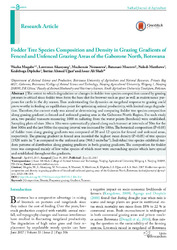| dc.contributor.author | Mugabe, Wazha | |
| dc.contributor.author | Akanyang, Lawrence | |
| dc.contributor.author | Nsinamwa, Mackenzie | |
| dc.contributor.author | Moatswi, Batanani | |
| dc.contributor.author | Matthews, Naledi | |
| dc.contributor.author | Dipheko, Kealeboga | |
| dc.contributor.author | Ujjan, Imtiaz Ahmed | |
| dc.contributor.author | Shah, Assar Ali | |
| dc.date.accessioned | 2022-10-19T10:23:37Z | |
| dc.date.available | 2022-10-19T10:23:37Z | |
| dc.date.issued | 2017-06-23 | |
| dc.identifier.citation | Mugabe, W., L. Akanyang, M. Nsinamwa, B. Moatswi, N. Matthews, K. Dipheko, I.A. Ujjan and A.A. Shah. 2017. Fodder tree species composition and density in grazing gradients of fenced and unfenced grazing areas of the Gaborone North, Botswana. Sarhad Journal of Agricul- ture, 33(2): 306-314 | en_US |
| dc.identifier.uri | http://dx.doi.org/10.17582/journal.sja/2017/33.2.306.314 | |
| dc.identifier.uri | https://hdl.handle.net/13049/573 | |
| dc.description.abstract | The extent to which degradation or changes in fodder tree species composition caused by grazing pressure is critical since fodder trees form the base diet for browser such as goat as well as maintenance purposes for cattle in the dry season. Thus, understanding the dynamics on rangeland response to grazing could prove worthy in finding an equilibrium point for optimizing animal productivity, with limited range degradation. Therefore, the current study was aimed at determining and comparing fodder tree species composition along grazing gradient in fenced and unfenced grazing area in the Gaborone North Region. For each study area, two parallel transects measuring 1000 m radiating from the water points (borehole) were established. Sampling plots of sizes 10m x 10m were systematically placed along each transect at intervals of 50m for the first 500m and the last 500m the spacing interval was increased by 100m. The botanical composition (P<0.05) of fodder trees along grazing gradients was composed of 20 and 12 species for fenced and unfenced areas, respectively. The grazing gradient in fenced area recorded the highest mean density (P<0.05) of tree species (1928 units ha−1) as compared to the unfenced area (968.3 units/ha−1). Individual tree species exhibited random patterns of distribution along grazing gradients in both grazing gradients. The composition for fodder trees was composed mainly of low value species of which most were encroaching species which have spread and established throughout the gradients. | en_US |
| dc.language.iso | en | en_US |
| dc.publisher | Cross Mark | en_US |
| dc.relation.ispartofseries | Sarhad Journal of Agricul- ture;33(2): 306-314 | |
| dc.subject | Composition | en_US |
| dc.subject | Density | en_US |
| dc.subject | Frequency grazing | en_US |
| dc.subject | Gradient | en_US |
| dc.subject | Transect | en_US |
| dc.title | Fodder Tree Species Composition and Density in Grazing Gradients of Fenced and Unfenced Grazing Areas of the Gaborone North, Botswana. | en_US |
| dc.type | Article | en_US |

